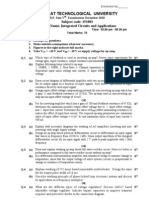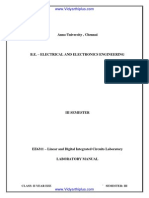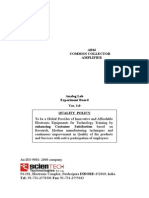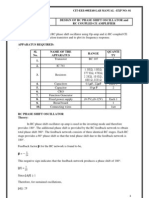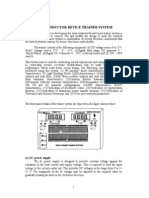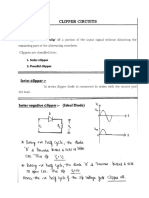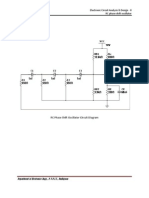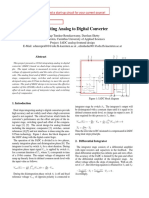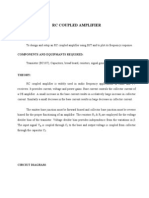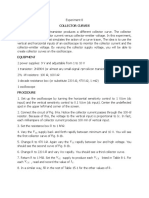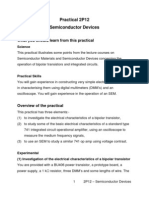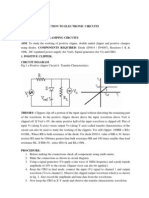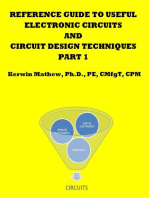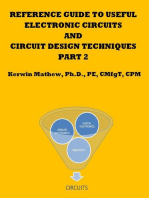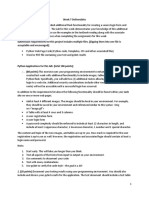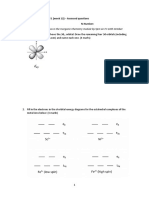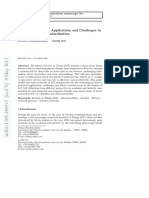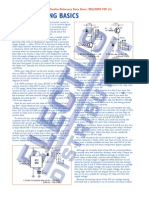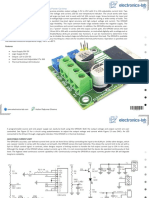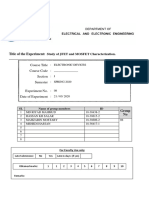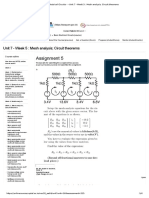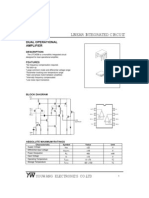Professional Documents
Culture Documents
Lab Report of Analogue Electronic
Lab Report of Analogue Electronic
Uploaded by
King EverestOriginal Description:
Original Title
Copyright
Available Formats
Share this document
Did you find this document useful?
Is this content inappropriate?
Report this DocumentCopyright:
Available Formats
Lab Report of Analogue Electronic
Lab Report of Analogue Electronic
Uploaded by
King EverestCopyright:
Available Formats
Lab Report of Analogue Electronic
ABSTRACT Analogue electronics are electronic systems that have a continuously varying signal with a proportional relationship existing between a signal and current or voltage Transistors! capacitors! resistors! inductors and diodes are the basic components in an analogue circuit board The Transistor "eedbac# Circuit circuit boards consist of three circuit bloc#s that include$ Series "eedbac#! %ultistage Amplifier "eedbac# and the &ifferential Amplifier "eedbac# The first three circuit bloc#s demonstrate feedbac# methods while the fourth one is used to demonstrate a differential amplifier An input signal with defined amplitude is fed into the circuit and it consists of a voltage with a certain value of current transistor Transistor "eedbac# Circuit board s carry three forms of feedbac# These include$ the Series Shunt feedbac# or the Series feedbac#! the %ultistage Amplifier "eedbac# consists of multistage series shunt feedbac# and multistage shunt series feedbac#! as well as the &ifferential Amplifier "eedbac# The multistage circuit involves two ma'or stages of amplification! using a combination of both shunt and series feedbac#
()TR*&+CT(*) "eedbac# in transistor feedbac#s refers to the return of a part of an amplifier,s output signal There are only two types of feedbac#s! the positive and the negative feedbac#s The positive feedbac# produces a signal that in turn ma#es the transistor circuit to deliver a larger signal The feedbac# is in the form of a signal moving in a negative direction (n the negative feedbac#! a signal bac#-passes to a previous stage and reduce the signal amplitude (n both cases! a feedbac# signal is of greater effect on the troughs and pea#s that represent distortions &ifferential amplifier is an amplifier with output signals that is proportional to the difference between input signals The attenuator and a generator buffer are incorporated into the circuit board to reduce the magnitude of the input signal (n this experiment! the #ey ob'ective was to locate and identify the circuit boards of Transistor "eedbac#s *ther ob'ectives of the experiment include$ gaining ability in describing effect of series shunt feedbac# by use of &C and AC gain measurements To observe the characteristics and operation of the multistage amplifiers! and differential amplifier and to understand how bandwidth is affected by the series negative feedbac# using feedbac# circuit Also! to gain ability in calculation and measure current gain in shunt series and be able to measure output impedance of the shunt-series multistage amplifier
T.E*R/ The set up of this experiment was based on the four ma'or Transistor "eedbac# Circuits mentioned above %ost transistors have leads in a single line with plastic cases They have a current gain of 011! up to 234 of the rated current This falls to 31 for the following 234 current increase This further falls to 51 for the following 234 in current gain and 01 at the maximum allowable current The transistor arrangement is slightly changed to come up with various feedbac# circuits with new features The diagram below shows circuits of the Transistor "eedbac# Circuit
E6+(7%E)T +SE& "*R T.E E87ER(%E)T Setting up this experiment re9uired the following lab e9uipment$ "ault Assisted Circuits for Electronics Training :" A C E T ; base unit! %ultimeter! 03v &C power supply! *scilloscope! &ual trace <enerator! Transistor feedbac# circuit and Transistor feedbac# Circuit circuit board
+)(T 0= Series "eedbac# 7rocedure The series feedbac# variable supply was ad'usted to >01?d c and R5 set to obtain 3 3?d c at the transistor collector 60! then ch0was connected to display ?b Ch2 was connected to display ?o at 62 output and the generator set for 5?p#-p# and01#h@ sine wave at 60 output To measure gain with feedbac#! the connector was removed and the generator ad'usted to obtain ?o Ch0was connected to the output ?o and the generator set for 2?p#-p#! 23 #.@ s9uare wave
and the scope was set at 3 SAdiv The vertical and hori@ontal positioning was ad'usted and the upper cutoff fre9uency calculated C2 was removed to add ac gain and the generator set at 2?p#-
p#!
011 #.@ s9uare wave at output ?o ! scope at 0 sAdiv C2 was then put bac# to the circuit and
the generator set at 2?p#-p#! 31.@ s9uare wave at output! and the oscilloscope set for 1 2%sAdiv The procedure was repeated with C2 removed from the circuit to add ac gain and oscilloscope set for 0mSAdiv Ch0 was then connected to the input ?i! the generator set at B1m?p#-p# and B1#.@ sin wave Ch2 was connected to display ?b and the oscilloscope set at 31%vAdiv ?R0 was measured and li and Ci calculated C2 was disconnected to introduce a feedbac# and ?i ad'usted to B1m?p#-p# Results and &iscussion Exercise 0= Effect of feedbac# on AC gain
The series feedbac# amplifier circuit bloc# develops series and shunt feedbac# that is parallel to the amplifier input The feedbac# causes a significant reduction in gain and the results obtained show that the measured "f is the same as the calculated Af Exercise 2= Effect of feedbac# in bandwidth
The negative feedbac# reduces the amplitude of the output amplifier! and improves the low and high fre9uency responses (n determining the cutoff fre9uency of an amplifier! the s9uare wave is more convenient to sine wave
Exercise 5= Effect of feedbac# on impedance
(ncreasing the circuit input impedance reduces the input current and addition of the series feedbac# increases the input impedance The transistor base impedance D
+nit 2= %ultistage amplifier feedbac# 7rocedure A multistage shunt-series feedbac# circuit was used in this experiment The oscilloscope ch0 was connected between ?o and the ground and the generator set for 011 m? p#-p#! 01 #.@ across R00 and the current through it was calculated Ch0 was then connected to the 'unction of C0 and R0 while Ch2 to the base of 60! and Ch2 was set to invert Ch0 was then connected between R00 and the output ?o measured The generator was then set for 5?p#-p# and 01 #.@ sine wave at the amplifier output RE CCF was then ad'usted to obtain a maximum resistance The post connecter between RE and the output was removed and the generator ad'usted to ?o D 5?p#-p# The ohmmeter was then disconnected and two post connectors inserted at RE to obtain ?oD0 3?p#-p# RE was disconnected and post connectors connected above RE! and then CF fully set to minimi@e resistance The generator was then set at 01 #.@! 0?p#-p# sine wave and Av calculated C%B was then activated to reduce RB set for 0?p#-p# at ?o! then ?i measured on ch! and Av calculated The generator was again set for 211m?p#-p#! 01 #.@ sine wave and R00set fully CF and connector inserted between R00 and R02 with R00 ad'usted to obtain 011m? p#-p# at the output C%01 was activated to reduce RE and the generator set for 211m? p#-p#! 01 #.@ sine wave at the output The connector at R00 was inserted and ad'ustments made to obtain 011m?p#-p# C%B was then activated to reduce RE and the generator set for 211m? p#-p#! 01 #.@ sine wave at the output The connector at R00 was inserted to obtain 011m?p#-p#
Results and &iscussion Exercise 0= Shunt - series current gain
Fhen Ch0 is connected between R00 and the output!
The resistor Rsh in the circuit provides the input with a shunt feedbac# while resistor Rsh provides series feedbac# for the output The voltage gain is less than the current gain that can be determined from the ratio= Current gainD
Exercise 2= Shunt - series output impedance
The output impedance of the circuit is high with the output current being essentially constant due to the high impedance The impedance decreases by the value of the collector resistor .ence! output impedance! Co output collector resistor! Rc and!
Fhen the output voltage! ?o D31m?p#-p#! the output current (o is given by$
Exercise 5= Series - shunt voltage gain There is a series feedbac# at the input stage and shunt feedbac# at the output stage The voltage gain varies directly with the circuit feedbac# ratio and is given by$ AvDRshARef
Exercise G= Series - shunt output impedance Fhen the connector between R00 and R02 is removed and C%01 is activated! R00>R02D011 ! representing a 534 change in collector value Fhen the connector is removed and C%B activated! R00>R02D 011 in collector value ! representing B24 change
The output impedance of a series-shunt feedbac# is low and is not related directly to the collector resistance
+nit 5= &ifferential feedbac# amplifier 7rocedure A differential amplifier was used with a voltmeter connected across collectors 60 and 62 and RG ad'usted until 1?dc was obtained The voltmeter was then connected across R5 and ?R5 measured and (R5 calculated A dc ammeter was connected in series across R3and and A" generator with two post connectors at 60 base Ch0 was connected to 60 base and the generator set for 311m?p#-p#! 0 #.@ sine wave at the input Ch2 was connected to 62 and both set for 1 3?Adiv and ch0 triggered A" generator was connected with two post connectors at the 60 base Ch0 was then connected to the 60 base and the generator set for 311m?p#-p# ! 0H.@ sine wave Ch2 was connected to 62 and the output signal output measured Ch2 was connected to the collector 62 with the input voltage still at 311m?p#-p# and ch2 moved to 60 collector Ch2 and ch0 were set for 1 3 ?Adiv and the differential output voltage measured across 60 and 62 and Av calculated Two post connectors were used at R0 with 3? dc at both inputs and the collector voltage recorded and the common mode voltage gain obtained Ch0 was connected to the A" generator and set for 3?p#-p# ! 0H.@ sine wave Ch0 was then moved the collector 60! and ch2 to 62 and the two set at 011m?Adiv Results and &iscussion
Exercise 0= Characteristics of differential amplifier The collector signal becomes out of phase with the input base signal and is positive when the base is negative and vice versa (R5 divides voltage e9ually between each collector series The 62 collector signal is in phase with the input signal at 60 The output of the differential amplifier has amplitude twice the single ended output
Exercise 2= Single ended and differential gain of differential amplifier
The sum of the two e9ual single ended gains is the differential output of the amplifier Exercise 5= Common mode gain of differential amplifier The dc and ac signals that are common to both inputs are re'ected by the differential amplifier (t was also found that the differential voltage remains constant between collectors and is decreased by an e9ual amount
C*)CL+S(*) The negative feedbac# results to a significant decrease in the circuit gain and increases the bandwidth! and decreases the gain in the amplifier Addition of the series negative feedbac# to a common emitter amplifier leads to an increase of the input impedance
You might also like
- 15 To 60 Watt Audio Amplifiers Using Complementary Darlington Output Transistors - An-483BDocument8 pages15 To 60 Watt Audio Amplifiers Using Complementary Darlington Output Transistors - An-483BAnonymous kdqf49qb100% (1)
- DFT AcronymsDocument4 pagesDFT Acronymspravallika vysyarajuNo ratings yet
- Lab Report of Analogue ElectronicDocument8 pagesLab Report of Analogue ElectronicKing EverestNo ratings yet
- Class B Push PullDocument21 pagesClass B Push PullMahesh ShuklaNo ratings yet
- 151003Document2 pages151003Er Nikesh PatelNo ratings yet
- Inverting and Non-Inverting Amplifiers: Pre-Lab QuestionsDocument13 pagesInverting and Non-Inverting Amplifiers: Pre-Lab QuestionsBereket TsegayeNo ratings yet
- EE6311 LIC Lab - VidyarthiplusDocument66 pagesEE6311 LIC Lab - VidyarthiplusArun KumarNo ratings yet
- Mit Aec Labmanula 10esl37Document45 pagesMit Aec Labmanula 10esl37anon_70724250No ratings yet
- AB 16 Wzmacniacz Ze Wspolnym Kolektorem 2Document21 pagesAB 16 Wzmacniacz Ze Wspolnym Kolektorem 2ReddyKishoreNo ratings yet
- RC Phase Shift Oscillator and RC Coupled Ce Amplifier - Lab ExperimentDocument8 pagesRC Phase Shift Oscillator and RC Coupled Ce Amplifier - Lab ExperimentMani BharathiNo ratings yet
- Common Emitter Amplifier: S.No Name of The Component/ Equipment Specifications QtyDocument0 pagesCommon Emitter Amplifier: S.No Name of The Component/ Equipment Specifications Qtyagama1188No ratings yet
- Lab ManualDocument87 pagesLab ManualSrividya KondaguntaNo ratings yet
- Adc Lab Manual PDFDocument74 pagesAdc Lab Manual PDFJega Deesan75% (4)
- AEC NotesDocument271 pagesAEC Notes1DS19EC726- Pankaj Ashok M.No ratings yet
- EX - NO:02 Design of Integrator and Differentiator Using Op-Amp DateDocument9 pagesEX - NO:02 Design of Integrator and Differentiator Using Op-Amp DateVijayakumar KNo ratings yet
- RC Phase Shift Oscillator PDFDocument9 pagesRC Phase Shift Oscillator PDFA B ShindeNo ratings yet
- AEC LabManualDocument30 pagesAEC LabManualPrateek PaliwalNo ratings yet
- RC Phase Shift Oscillator AimDocument2 pagesRC Phase Shift Oscillator AimjGBJKgkjdaNo ratings yet
- Multivibrator Manual PDFDocument73 pagesMultivibrator Manual PDFAvijitRoyNo ratings yet
- Nollido Acee6l Exp6 Ee2hDocument10 pagesNollido Acee6l Exp6 Ee2hrusselpagaoNo ratings yet
- An 311Document6 pagesAn 311ayatullah21No ratings yet
- Ade Lab ManualDocument104 pagesAde Lab Manualsrinureddy2014No ratings yet
- LIC Lab ManualDocument43 pagesLIC Lab ManualManoj DNo ratings yet
- Ecet Eca Lab ManualDocument47 pagesEcet Eca Lab ManualR RajenderNo ratings yet
- Objectives:: Electronics I Laboratory - EXPERIMENT 10 Common Emitter AmplifierDocument6 pagesObjectives:: Electronics I Laboratory - EXPERIMENT 10 Common Emitter AmplifierRabindraMaharanaNo ratings yet
- Experiment 1Document9 pagesExperiment 1Chamodi KodithuwakkuNo ratings yet
- Summing and Difference Amplifier: Paolo Louis Manghihilot John Carlo TigueDocument6 pagesSumming and Difference Amplifier: Paolo Louis Manghihilot John Carlo TigueJohnCarloTigueNo ratings yet
- Analog Communications Lab ManualDocument60 pagesAnalog Communications Lab ManualmailmeasddNo ratings yet
- Integrating ADCDocument10 pagesIntegrating ADCchintu333No ratings yet
- EC Lab ManualDocument27 pagesEC Lab ManualMohan KumarNo ratings yet
- List of ExperimentsDocument22 pagesList of ExperimentsloganathanNo ratings yet
- RC Coupled Amplifier With ResponseDocument7 pagesRC Coupled Amplifier With ResponselekhapankajNo ratings yet
- Mac Int J.Power ElectronicsDocument14 pagesMac Int J.Power Electronicssandeepbabu28No ratings yet
- Lab Report Operation of A RF Class-A Tuned AmplifierDocument7 pagesLab Report Operation of A RF Class-A Tuned AmplifierKugaa NesvaranNo ratings yet
- Wein Bridge Oscillator: f =1/2π√R1C1R2C2Document11 pagesWein Bridge Oscillator: f =1/2π√R1C1R2C2krishna goggiNo ratings yet
- Experiment 8Document3 pagesExperiment 8Nathaniel MendozaNo ratings yet
- QB On Integrated Circuit and ApplicationsDocument4 pagesQB On Integrated Circuit and ApplicationsFarooq KhandayNo ratings yet
- Practical 2P12 Semiconductor Devices: What You Should Learn From This PracticalDocument11 pagesPractical 2P12 Semiconductor Devices: What You Should Learn From This PracticalDevesh GargNo ratings yet
- Sharmi ECE a-D-Circuits Lab ManualDocument74 pagesSharmi ECE a-D-Circuits Lab ManualSharmila83No ratings yet
- Exercise Chapter 2Document7 pagesExercise Chapter 2DonkeyTank67% (3)
- EC &LD-Lab ManualDocument50 pagesEC &LD-Lab Manualdevirpasad100% (1)
- Plugin-TE0221 - Analog & Digital System LabDocument53 pagesPlugin-TE0221 - Analog & Digital System Labnainesh goteNo ratings yet
- "Power Electronics" (Lab 5: DC-AC Inverter) : Instructor: StudentDocument24 pages"Power Electronics" (Lab 5: DC-AC Inverter) : Instructor: StudentNOV DAVANNNo ratings yet
- Lab ManualDocument56 pagesLab ManualNishant AgrawalNo ratings yet
- DLC Lab ManualDocument59 pagesDLC Lab ManualkulamangalamNo ratings yet
- BJT Amplifiers Frequency ResponseDocument29 pagesBJT Amplifiers Frequency ResponseKrista JacksonNo ratings yet
- Universidad Nacional Autónoma de México: Facultad de Estudios Superiores Cuautitlán. Campo 4Document4 pagesUniversidad Nacional Autónoma de México: Facultad de Estudios Superiores Cuautitlán. Campo 4Luis FigueroaNo ratings yet
- Ec FinalDocument46 pagesEc FinalManjunath YadavNo ratings yet
- LM 13700Document24 pagesLM 13700Pinto Condori JesusNo ratings yet
- Analog Sensor InterfacingDocument5 pagesAnalog Sensor Interfacingkokolanski100% (1)
- EDC Lab ManualDocument48 pagesEDC Lab ManualDishan D Shah100% (1)
- Com Lab ManualDocument59 pagesCom Lab ManualAngels N Queens100% (1)
- Instrumentation Lab ManualDocument14 pagesInstrumentation Lab ManualAmulyaNo ratings yet
- Precision Constant Current Source For Electrical Impedance TomographyDocument4 pagesPrecision Constant Current Source For Electrical Impedance Tomographyjorgeluis.unknownman667No ratings yet
- Operational Amplifier LAbDocument17 pagesOperational Amplifier LAbAhmad DboukNo ratings yet
- Lab. Exercise PL1 CC/CC Converters: Electrònica de Potència Grau en Enginyeria Electrònica Industrial I AutomàticaDocument8 pagesLab. Exercise PL1 CC/CC Converters: Electrònica de Potència Grau en Enginyeria Electrònica Industrial I AutomàticageovannyNo ratings yet
- Reference Guide To Useful Electronic Circuits And Circuit Design Techniques - Part 1From EverandReference Guide To Useful Electronic Circuits And Circuit Design Techniques - Part 1Rating: 2.5 out of 5 stars2.5/5 (3)
- Reference Guide To Useful Electronic Circuits And Circuit Design Techniques - Part 2From EverandReference Guide To Useful Electronic Circuits And Circuit Design Techniques - Part 2No ratings yet
- STEM: Science, Technology, Engineering and Maths Principles Teachers Pack V10From EverandSTEM: Science, Technology, Engineering and Maths Principles Teachers Pack V10No ratings yet
- Emerging Security ThreatsDocument7 pagesEmerging Security ThreatsKing EverestNo ratings yet
- Lab7 6437074763336854Document2 pagesLab7 6437074763336854King EverestNo ratings yet
- Submit Answers To The Dropbox in The Inorganic Chemistry Module by 5pm On Fri 16th OctoberDocument2 pagesSubmit Answers To The Dropbox in The Inorganic Chemistry Module by 5pm On Fri 16th OctoberKing EverestNo ratings yet
- Instructions For Work in LabDocument2 pagesInstructions For Work in LabKing EverestNo ratings yet
- Prospects and Challenges of Workplace Diversity in Modern Day Organizations: A Critical ReviewDocument18 pagesProspects and Challenges of Workplace Diversity in Modern Day Organizations: A Critical ReviewKing EverestNo ratings yet
- 4 Background Radiation PDFDocument1 page4 Background Radiation PDFKing EverestNo ratings yet
- Routing ProtocolDocument17 pagesRouting ProtocolKing EverestNo ratings yet
- Choosing R-Tree or Quadtree Spatial Data Indexing in One Oracle Spatial Database System To Make Faster Showing Geographical Map in Mobile Geographical Information System TechnologyDocument9 pagesChoosing R-Tree or Quadtree Spatial Data Indexing in One Oracle Spatial Database System To Make Faster Showing Geographical Map in Mobile Geographical Information System TechnologyKing EverestNo ratings yet
- AssignmentDocument2 pagesAssignmentKing EverestNo ratings yet
- PPPoE Server Setup PDFDocument5 pagesPPPoE Server Setup PDFKing EverestNo ratings yet
- Identification and Expression Analysis of MATE Genes Involved in Flavonoid Transport in Blueberry PlantsDocument21 pagesIdentification and Expression Analysis of MATE Genes Involved in Flavonoid Transport in Blueberry PlantsKing EverestNo ratings yet
- 1105 1693 PDFDocument24 pages1105 1693 PDFKing EverestNo ratings yet
- Case Study AssignmentDocument1 pageCase Study AssignmentKing EverestNo ratings yet
- ARM Processor ArchitectureDocument10 pagesARM Processor ArchitectureKing EverestNo ratings yet
- Chapter 09Document26 pagesChapter 09Muhammad Ibrahim MarwatNo ratings yet
- Experimental Evaluation of Spatial Indices With Festival: October 2016Document7 pagesExperimental Evaluation of Spatial Indices With Festival: October 2016King EverestNo ratings yet
- Hicourt Industries Is A Commercial Printing Outfit in A Medium-SizeDocument5 pagesHicourt Industries Is A Commercial Printing Outfit in A Medium-SizeKing EverestNo ratings yet
- Probability and Confidence IntervalsDocument14 pagesProbability and Confidence IntervalsKing EverestNo ratings yet
- Texas City Interim Mogford Report With AppendicesDocument47 pagesTexas City Interim Mogford Report With AppendicesKing EverestNo ratings yet
- Driver RelayDocument2 pagesDriver Relaysandi sukma100% (1)
- 78S40Document0 pages78S40Pravin MevadaNo ratings yet
- 1.2V 25V10A Adjustable Power Supply Using Power Op AmpDocument3 pages1.2V 25V10A Adjustable Power Supply Using Power Op AmpJavier SotoNo ratings yet
- HCF4007Document9 pagesHCF4007Charlie DavidsNo ratings yet
- 1 Sushilkumar Rameshwar RajguruDocument12 pages1 Sushilkumar Rameshwar RajguruSHUBHAM AMBOLKARNo ratings yet
- JK RS T Flip-Flop DesignDocument19 pagesJK RS T Flip-Flop DesignvijaykannamallaNo ratings yet
- 5-Band Graphic Equalizer: EE 410 Final Linear Electronic Design Spring 2008Document13 pages5-Band Graphic Equalizer: EE 410 Final Linear Electronic Design Spring 2008Zeeshan JohnNo ratings yet
- Sa-A KX440Document5 pagesSa-A KX440Edwin BerruetaNo ratings yet
- 6Q7 9Q8 1 1 Q9 1 2 Q 5 - 9 1Gnd 2Trg 3out 4Rst5Ctl 6Thr 7dis 8VccDocument4 pages6Q7 9Q8 1 1 Q9 1 2 Q 5 - 9 1Gnd 2Trg 3out 4Rst5Ctl 6Thr 7dis 8VccAlexon DomingoNo ratings yet
- Basic Electronics Question Bank-2023-DecDocument10 pagesBasic Electronics Question Bank-2023-Decpratiksharma2828No ratings yet
- Radio Lv23100v Spec enDocument13 pagesRadio Lv23100v Spec envetchboyNo ratings yet
- Class-B Amplifier Design by P BlomleyDocument10 pagesClass-B Amplifier Design by P BlomleyMustafa Umut Sarac100% (1)
- Setting Up A Fiber Optic Digital LinkDocument5 pagesSetting Up A Fiber Optic Digital LinkDayanand Gowda Kr100% (1)
- FM Using PLL CompressDocument8 pagesFM Using PLL CompressKARKAR NORANo ratings yet
- Dokumen - Tips - System On Chip Soc 5584a750d1651Document21 pagesDokumen - Tips - System On Chip Soc 5584a750d1651pankaj chandankhedeNo ratings yet
- Chapter 4 - Analog Signal ConditioningDocument85 pagesChapter 4 - Analog Signal ConditioningVon JinNo ratings yet
- Device Lab Report 8 PDFDocument10 pagesDevice Lab Report 8 PDFScribble RiYaDNo ratings yet
- Ripple BlankingDocument3 pagesRipple Blankingpawan_32No ratings yet
- In ENG Module Handbook EB184503 Instrumentasi Biomedika Dan LaboratoriumDocument24 pagesIn ENG Module Handbook EB184503 Instrumentasi Biomedika Dan LaboratoriumAngga FeldyansyahNo ratings yet
- Icom IC-R3 Service ManualDocument61 pagesIcom IC-R3 Service ManualYayok S. AnggoroNo ratings yet
- Assignment 5: Unit 7 - Week 5: Mesh Analysis Circuit TheoremsDocument6 pagesAssignment 5: Unit 7 - Week 5: Mesh Analysis Circuit TheoremssabilashNo ratings yet
- Linear Integrated Circuit: Dual Operational AmplifierDocument5 pagesLinear Integrated Circuit: Dual Operational AmplifierMarcosMoraesNo ratings yet
- Practice Problems For Chapter 5 and 6Document11 pagesPractice Problems For Chapter 5 and 6Mark Asesor Calonzo0% (2)
- Physical DesignDocument45 pagesPhysical DesignMalka RavikrishnaNo ratings yet
- KNR1723 2122Tutorial02SolutionwrewrweDocument18 pagesKNR1723 2122Tutorial02SolutionwrewrweSebastianNo ratings yet
- Model Question Paper: Using Norton's Theorem, Find The Constant-Current Equivalent of The Circuit Shown in Fig BelowDocument4 pagesModel Question Paper: Using Norton's Theorem, Find The Constant-Current Equivalent of The Circuit Shown in Fig BelowMaster GuruNo ratings yet
- Datasheet Power Factor CorrectorDocument11 pagesDatasheet Power Factor CorrectorSeptimo GuevaraNo ratings yet
- Ecs-301 Digital Logic Design 2011-12Document7 pagesEcs-301 Digital Logic Design 2011-12Satyedra MauryaNo ratings yet
- PCS - D2 - Cat Ii QP - 1 - 2 - 5Document2 pagesPCS - D2 - Cat Ii QP - 1 - 2 - 5Nava GaneshNo ratings yet




